


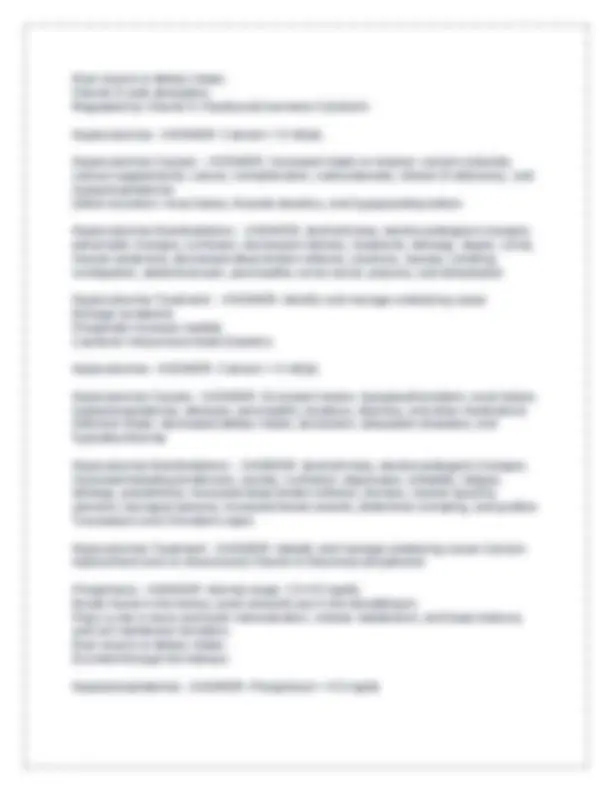

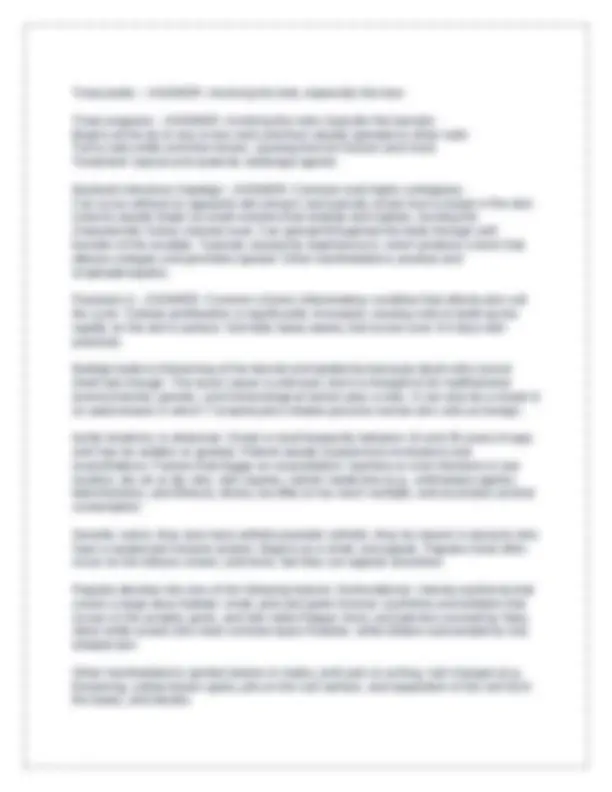


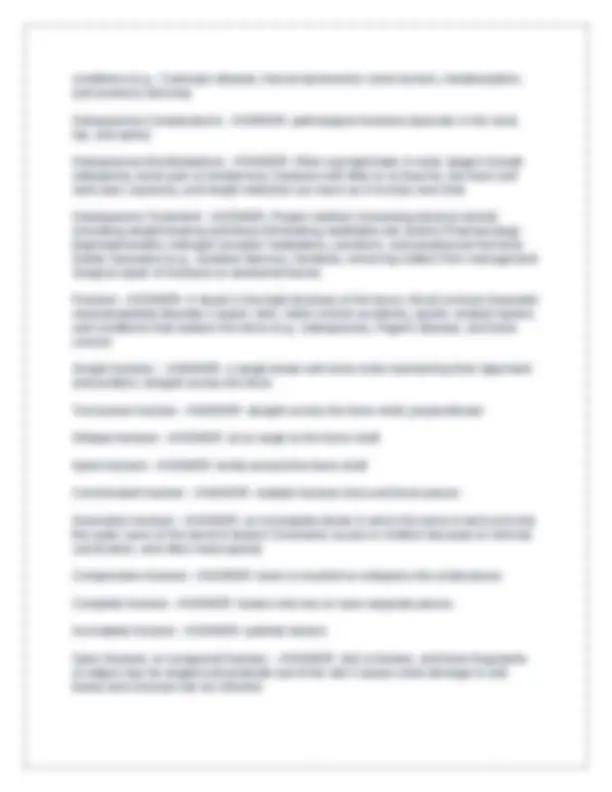
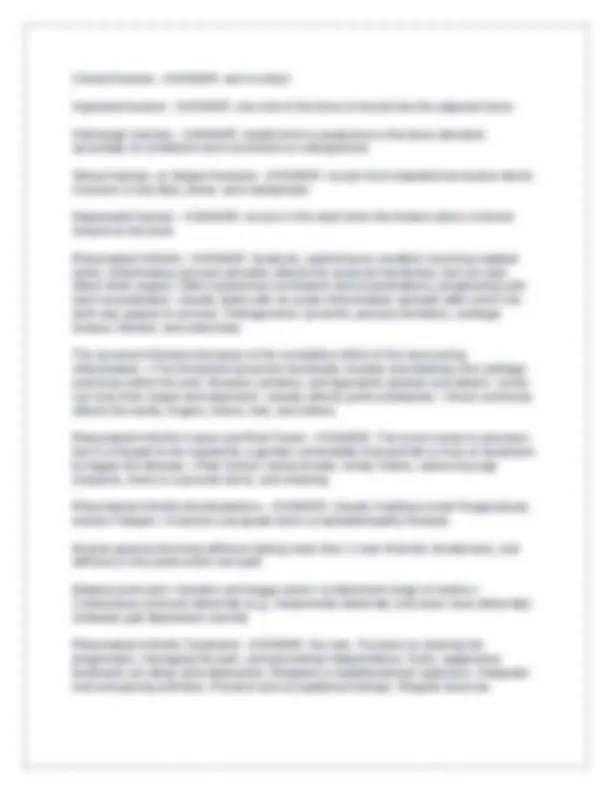
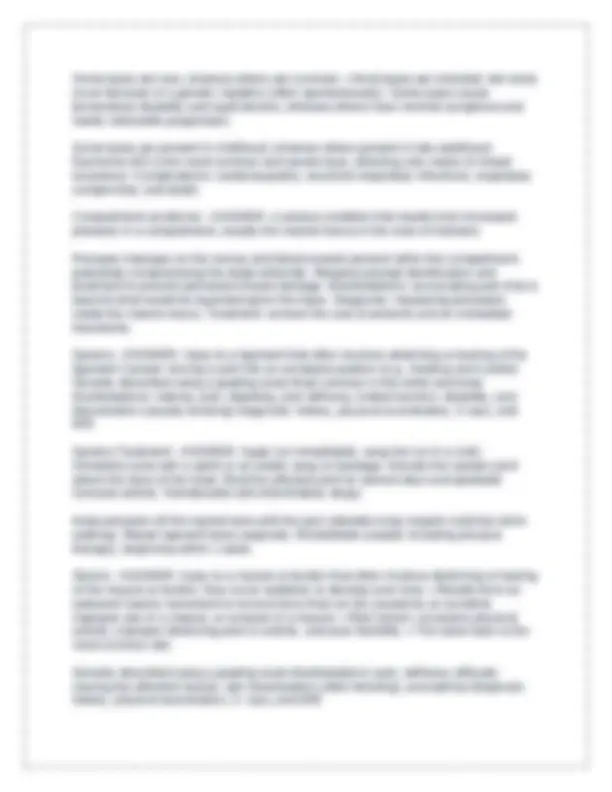





Study with the several resources on Docsity

Earn points by helping other students or get them with a premium plan


Prepare for your exams
Study with the several resources on Docsity

Earn points to download
Earn points by helping other students or get them with a premium plan
Community
Ask the community for help and clear up your study doubts
Discover the best universities in your country according to Docsity users
Free resources
Download our free guides on studying techniques, anxiety management strategies, and thesis advice from Docsity tutors
A comprehensive set of questions and answers related to pathophysiology, covering topics such as the stages of general adaptation syndrome, fluid imbalances, electrolyte disorders, and cancer. It is a valuable resource for students studying pathophysiology at rasmussen university.
Typology: Exams
1 / 21

This page cannot be seen from the preview
Don't miss anything!














Stages of general adaptation syndrome - ANSWER- 1. Alarm Initial reaction Sympathetic nervous system
Deydration Manisfestations - ANSWER- thirst, altered level of consciousness, hypotension, tachycardia, weak and thready pulse, flat jugular veins, dry mucous membranes, decreased skin turgor, oliguria, weight loss, and sunken fontanelles Cancer Benign - ANSWER- Slow, progressive, localized, well defined, resembles host (more differentiated), grows by expansion, does not usually cause death Cancer Malignant - ANSWER- Rapid growing, spreads (metastasis) quickly, fatal, highly undifferentiated Sodium - ANSWER- Normal range: 135-145 mEq/L.
Main source is dietary intake. Excreted through the kidneys and gastrointestinal tract. Serum potassium cannot fluctuate much without causing serious issue. Hyperkalemia - ANSWER- Potassium > 5 mEq/L Hyperkalemia Causes - ANSWER- Deficient excretion: renal failure, Addison's disease, certain medications, and Gordon's syndrome Excessive intake: oral potassium supplements, salt substitutes, and rapid intravenous administration of diluted potassium Increased release from cells: acidosis, blood transfusions, and burns or any other cellular injuries Hyperkalemia Manifestions: - ANSWER- paresthesia, muscle weakness, flaccid paralysis, bradycardia, dysrhythmias, electrocardiogram changes, cardiac arrest, respiratory depression, abdominal cramping, nausea, and diarrhea Hyperkalemia Treatment: - ANSWER- Correct acidosis, usually with sodium bicarbonate Calcium gluconate to minimize dysrhythmias Decrease dietary potassium intake Increase excretion by Dialysis Kayexalate Intravenous fluids Potassium-losing diuretics Facilitate cellular exchange Insulin Hypokalemia - ANSWER- Potassium < 3.5 mEq/L Hypokalemia Causes - ANSWER- Excessive loss: vomiting, diarrhea, nasogastric suctioning, fistulas, laxatives, potassium-losing diuretics, Cushing's syndrome, and corticosteroids Deficient intake: malnutrition, extreme dieting, and alcoholism Increased shift into the cell: alkalosis and insulin excess Hypokalemia Manifestations: - ANSWER- muscle weakness, paresthesia, hyporeflexia, leg cramps, weak and irregular pulse, hypotension, dysrhythmias, electrocardiogram changes, decreased bowel sounds, abdominal distension, constipation, ileus, and cardiac arrest Hypokalemia Treatment: - ANSWER- identify and manage underlying cause along with potassium replacement (oral or intravenous) Calcium - ANSWER- Normal range: 4-5 mEq/L Mostly found in the bone and teeth Plays a role in blood clotting, hormone secretion, receptor functions, nerve transmission, and muscular contraction Has inverse relationship with phosphorus Has synergistic relationship with magnesium
Main source is dietary intake. Vitamin D aids absorption. Regulated by Vitamin K Parathyroid hormone Calcitonin Hypercalcemia - ANSWER- Calcium > 5 mEq/L Hypercalcemia Causes: - ANSWER- Increased intake or release: calcium antacids, calcium supplements, cancer, immobilization, corticosteroids, vitamin D deficiency, and hypophosphatemia Deficit excretion: renal failure, thiazide diuretics, and hyperparathyroidism Hypercalcemia Manifestations: - ANSWER- dysrhythmias, electrocardiogram changes, personality changes, confusion, decreased memory, headache, lethargy, stupor, coma, muscle weakness, decreased deep tendon reflexes, anorexia, nausea, vomiting, constipation, abdominal pain, pancreatitis, renal calculi, polyuria, and dehydration Hypercalcemia Treatment: - ANSWER- Identify and manage underlying cause Manage symptoms Phosphate Increase mobility Calcitonin Intravenous fluids Diuretics Hypocalcemia - ANSWER- Calcium < 4 mEq/L Hypocalcemia Causes - ANSWER- Excessive losses: hypoparathyroidism, renal failure, hyperphosphatemia, alkalosis, pancreatitis, laxatives, diarrhea, and other medications Deficient intake: decreased dietary intake, alcoholism, absorption disorders, and hypoalbuminemia Hypocalcemia Manifestations: - ANSWER- dysrhythmias, electrocardiogram changes, increased bleeding tendencies, anxiety, confusion, depression, irritability, fatigue, lethargy, paresthesia, increased deep tendon reflexes, tremors, muscle spasms, seizures, laryngeal spasms, increased bowel sounds, abdominal cramping, and positive Trousseau's and Chvostek's signs Нуросalcemia Treatment - ANSWER- Identify and manage underlying cause Calcium replacement (oral or intravenous) Vitamin D Decrease phosphorus Phosphorus - ANSWER- Normal range: 2.5-4.5 mg/dL. Mostly found in the bones; small amounts are in the bloodstream. Plays a role in bone and tooth mineralization, cellular metabolism, acid base balance, and cell membrane formation. Main source is dietary intake. Excreted through the kidneys. Hyperphosphatemia - ANSWER- Phosphorus > 4.5 mg/dL
Type I, IgE mediated Examples: - ANSWER- Hay fever, food allergies, and anaphylaxis Type I, IgE mediated Treatment - ANSWER- includes epinephrine, antihistamines, corticosteroids, and desensitizing injections. Type II, cytotoxic hypersensitivity reaction - ANSWER- IgG or IgM type antibodies bind to antigen on individual's own cells. Antigen may be intrinsic or extrinsic. Recognition of these cells by macrophages triggers antibody production. Lysis of cells occurs because of the activation of the complement and by phagocytosis. Usually immediate responses. Type II, cytotoxic hypersensitivity reaction Examples: - ANSWER- Blood transfusion reaction and erythroblastosis Type II, cytotoxic hypersensitivity reaction Treatment - ANSWER- includes ensuring blood compatibility (transfusion) and administering medication to prevent maternal antibody development (Rho[D]). Type III, immune complex-mediated hypersensitivity reaction - ANSWER- Circulating antigen antibody complexes accumulate and are deposited in the tissue. Triggers the complement system, causing inflammation. Type III, immune complex-mediated hypersensitivity reaction Example: - ANSWER- Autoimmune conditions (e.g., systemic lupus erythematosus) Type III and Type IV: Treatment - ANSWER- is disease specific. Type IV, delayed hypersensitivity reaction - ANSWER- Cell-mediated rather than antibody-mediated involving the T cells. Antigen presentation results in cytokine release, leading to inflammation. Causes severe tissue injury and fibrosis Type IV, delayed hypersensitivity reaction Examples: - ANSWER- Tuberculin skin testing, transplant reactions, and contact dermatitis Immunodeficiency - ANSWER- Diminished or absent immune response Renders the person susceptible to disease normally prevented Opportunistic infections May be acute or chronic Classifications Primary Secondary HIV - ANSWER- Parasitic retrovirus that infects CD4 and macrophages upon entry In the US, rates rising among women and African Americans Transmission Blood and bodily fluids
HIV Type 1 - ANSWER- is the most common strain. HIV Type 2 - ANSWER- is more common in West Africa; progresses to disease more slowly. Verrucae - ANSWER- Warts caused by a number of human papillomaviruses. Can develop at any age and often resolve spontaneously. Transmitted through direct skin contact between people or within the same person. The human papillomavirus replicates in the skin cells, causing irregular thickening. Varying color, shape, and texture depending on type Herpes simplex type 1 - ANSWER- Typically affects the lips, mouth, and face. Usually begins in childhood. Can involve the eyes, leading to conjunctivitis. Can result in meningoencephalitis. Transmitted by contact with infected saliva. The primary infection may be asymptomatic. After the primary infection, the virus remains dormant in the sensory nerve ganglion to the trigeminal nerve until it is reactivated. Reactivation may be a result of an infection, stress, or sun exposure. When reactivated, causes painful blisters or ulcerations that are preceded by a burning or tingling sensation. The lesions resolve spontaneously within 3 weeks, but healing can be accelerated with administration of oral or topical antiviral agents. Herpes zoster (shingles) - ANSWER- Caused by the varicella-zoster virus. Appears in adulthood years after a primary infection of varicella in childhood. The virus lies dormant on a cranial nerve or a spinal nerve dermatome until it is activated years later. The virus affects this nerve only, giving the condition its typical unilateral manifestations. Herpes zoster (shingles) Manifestations: - ANSWER- pain, paresthesia, a red or silvery vesicular rash that develops in a line over the area innervated by the affected nerve (one side of the head or torso), extremely sensitive skin, and pruritis. The rash may persist for weeks to months. Herpes zoster (shingles) Complications: Treatment: - ANSWER- neuralgia and blindness. antivirals, antidepressants, and anticonvulsants. Parasitic Infections Tinea - ANSWER- Causes several types of superficial fungal infections. These fungi typically grow in warm, moist places (e.g., showers). Typically manifests as a circular, erythematous rash accompanied by pruritus and burning. Tinea capitis: - ANSWER- involving the scalp. Common in school-aged children. Hair loss at the site is common. Tinea corporis: - ANSWER- involving the body
Atopic Dermatitis - ANSWER- Also called eczema Chronic inflammatory condition triggered by an allergen Has an inherited tendency May be accompanied by asthma and allergic rhinitis Most common in infants and usually resolves by early adulthood Characterized by remissions and exacerbations Exact cause unknown, but may result from an immune system malfunction (similar to hypersensitivity reaction, i.e., IgE elevation present) Atopic march theory Atopic Dermatitis Complications - ANSWER- secondary bacterial skin infections, neurodermatitis (permanent scarring and discoloration from chronic scratching), and eye problems (e.g., conjunctivitis) May affect any area, but typically appears on the arms and behind the knees Atopic Dermatitis Manifestations - ANSWER- Red to brownish-gray skin patches Pruritus, which may be severe, especially at night Vesicles Thickened (lichenified), cracked, or scaly skin Irritated, sensitive skin from scratching Systemic Lupus Erythematosus - ANSWER- Chronic inflammatory autoimmune condition. May affect connective tissue of any body organ. Remission and exacerbations- -stressors tend to trigger. • Disease progression varies from mild to severe. More common in women, Asians, and African Americans. Cause is unclear, but it's thought that B cells are activated to produce autoantibodies and autoantigens that combine to form immune complexes, which attack the body's own tissues. Systemic Lupus Erythematosus manifestations - ANSWER- Immunological phenomena Antinuclear antibody Neurological disorders (seizures/psychosis) - Malar rash (butterfly rash over cheeks) - Discoid rash (patchy redness that can cause scarring) Systemic Lupus Erythematosus treatment - ANSWER- No cure only symptom management Stress management and health promotion behaviors - Pharmacological • NSAIDS, antimalarials, corticosteroids, immunosuppressants, and DMARDS Plasmapheresis Prognosis improves with early diagnosis and treatment. Yeast infection candidiasis - ANSWER- A fungal infection typically on the skin or mucous membranes caused by candida. Syphilis - ANSWER- is a bacterial infection usually spread by sexual contact. The disease starts as a painless sore - typically on your genitals, rectum or mouth. Syphilis spreads from person to person via skin or mucous membrane contact with these sores. Parasitic Infections Scabies - ANSWER- Result of a mite infestation. Male mites fertilize the females and then die. Female mites burrow into the epidermis, laying eggs over a
period of several weeks through a series of tracts. After laying the eggs, the female mites die. Larvae hatch from the eggs and migrate to the skin's surface. Larvae burrow in search of nutrients and mature to repeat the cycle. Burrowing appears as small, light brown streaks on the skin. Burrowing and fecal matter left by the mites triggers the inflammatory process, leading to erythema and pruritus. Mites can only survive for short periods without a host, so transmission usually results from close contact. Treatment: topical treatments. Parasitic Infections Pediculosis - ANSWER- Lice infestation: small, brown insects that feed off human blood and cannot survive long without host. Nits appear as small, white, iridescent shells on the hair. After hatching, the lice bite and suck the host's blood. Bite site develops a highly pruritic macule or papule. Easily transmitted through close contact. Treatment: several topical treatments. Pediculus humanus corpus: - ANSWER- body louse. Pediculus pubic: - ANSWER- pubic louse. Pediculus humanus capitis: - ANSWER- head louse. Pediculosis - ANSWER- Females lay nits on the hair shaft close to the scalp. Ticks - ANSWER- are small, blood-sucking bugs. They can range in size from as small as a pin's head to as large as a pencil eraser. pressure ulcers - ANSWER- Bedsores are injuries to skin and underlying tissue resulting from prolonged pressure on the skin. Bedsores most often develop on skin that covers bony areas of the body, such as the heels, ankles, hips and tailbone. Burns - ANSWER- Injury that can result from exposure to a thermal or nonthermal source Triggers inflammatory reaction and results in tissue destruction Burns Sources - ANSWER- dry heat (e.g., fire), wet heat (e.g., steam or hot liquids), radiation, friction, heated objects, natural or artificial UV light, electricity, and chemicals (e.g., acids, alkaline, and paint thinner) Burns First-degree burns: - ANSWER- affect only the epidermis and cause pain, erythema, and edema Burns Second-degree burns: - ANSWER- affect the epidermis and dermis and cause pain, erythema, edema, and blistering Burns Third-degree burns: - ANSWER- extend into deeper tissues and cause white or blackened, charred skin that may be numb
Rickets and Osteomalacia - ANSWER- Rickets: soft, weak bones in children, usually because of an extreme and prolonged vitamin D, calcium, or phosphate deficiency. Osteomalacia: adult form. Minerals shift out of the bone if the blood levels become too low, leading to weak and soft bones. Rickets and Osteomalacia Risk factors - ANSWER- vitamin D deficiency (e.g., being bedbound, institutionalized persons, working indoors, strong sunscreen use, celiac disease, cystic fibrosis, and undergoing gastrectomy), dietary imbalances, genetic influences, renal disease, and liver disease (in children). Rickets and Osteomalacia Manifestations - ANSWER- Develop slowly as the bones weaken Become apparent in children as the soft bones cannot support the growing child Fractures Skeletal deformities (e.g., bowed legs, asymmetrical skull, scoliosis, kyphosis, pelvic deformities, sternum projection) Delayed growth in height or limbs Dental problems - Bone pain - Muscle cramps or weakness Rickets and Osteomalacia Treatment - ANSWER- Correcting or managing the underlying cause Increasing calcium, phosphorus, or vitamin D intake Positioning or bracing to reduce or prevent deformities Surgical correction of severe deformities Osteoporosis - ANSWER- Metabolic condition characterized by a progressive loss of bone calcium that leaves the bones brittle. Can occur due to multiple pathogenetic mechanisms that interact to cause either a decrease in osteoblast activity or an increase in osteoclast activity. Spongy bone becomes porous, particularly in the vertebrae and wrist, and the compact bone becomes thin. Osteoporosis Causes - ANSWER- genetic predisposition, dietary imbalances (low calcium, protein, vitamin C, and vitamin D intake; high phosphorus intake), hormonal fluctuations (e.g., menopause), and physical inactivity Osteoporosis Risk factors - ANSWER- advancing age, being female, being underweight, undergoing gastrointestinal procedures (e.g., gastrectomy or gastrointestinal bypass), Caucasian ethnicity, Asian descent, smoking, excessive alcohol or caffeine consumption, using certain medications (e.g., corticosteroids, chemotherapy, thyroid replacements, heparin, and antacids), and certain health
conditions (e.g., Cushing's disease, thyroid dysfunction, bone tumors, malabsorption, and anorexia nervosa) Osteoporosis Complications - ANSWER- pathological fractures (typically in the wrist, hip, and spine) Osteoporosis Manifestations - ANSWER- Often asymptomatic in early stages Include osteopenia, bone pain or tenderness, fractures with little or no trauma, low back and neck pain, kyphosis, and height reduction (as much as 6 inches) over time Osteoporosis Treatment - ANSWER- Proper nutrition Increasing physical activity (including weight-bearing activities) Eliminating modifiable risk factors Pharmacology: bisphosphonates, estrogen receptor modulators, calcitonin, and parathyroid hormone Safety measures (e.g., assistive devices, handrails, removing clutter) Pain management Surgical repair of fractures or weakened bones Fracture - ANSWER- A break in the rigid structure of the bone • Most common traumatic musculoskeletal disorder Causes: falls, motor vehicle accidents, sports- related injuries, and conditions that weaken the bone (e.g., osteoporosis, Paget's disease, and bone cancer) Simple fracture: - ANSWER- a single break with bone ends maintaining their alignment and position; straight across the bone Transverse fracture - ANSWER- straight across the bone shaft; perpendicular Oblique fracture - ANSWER- at an angle to the bone shaft Spiral fracture - ANSWER- twists around the bone shaft Comminuted fracture - ANSWER- multiple fracture lines and bone pieces Greenstick fracture - ANSWER- an incomplete break in which the bone is bent and only the outer curve of the bend is broken Commonly occurs in children because of minimal calcification, and often heals quickly Compression fracture - ANSWER- bone is crushed or collapses into small pieces Complete fracture - ANSWER- broken into two or more separate pieces Incomplete fracture - ANSWER- partially broken Open fracture, or compound fracture: - ANSWER- skin is broken, and bone fragments or edges may be angled and protrude out of the skin Causes more damage to soft tissue and increase risk for infection
Pharmacologic therapies: Nonsteroidal anti-inflammatory drugs Corticosteroids (orally or as an intra-articular injection) Disease-modifying antirheumatic drugs (e.g., gold compounds, immunosuppressant agents, and antimalarial agents) Biologic response- modifying agents Herbal therapies including thunder god vine, plant oils, and fish oil Nonpharmacologic pain management Application of heat and cold Splint and braces Assistive devices (e.g., walkers and rails) Coping strategies and support Surgical repair (e.g., synovectomy and arthroplasty) Gout - ANSWER- Inflammatory disease resulting from deposits of uric acid crystals in tissues and fluids. Uric acid is a by-product of breaking down purines, a substance naturally found in the body and in certain foods (e.g., organ meats, shellfish, anchovies, herring, asparagus, and mushrooms). • Results from hyperuricemia caused by an overproduction or underexcretion (most common) of uric acid. Not all people with hyperuricemia have gout. Most common in males and African Americans. Causes: inborn error in metabolism, being overweight or obese, having certain diseases (e.g., hypertension, diabetes mellitus, renal disease, and sickle cell anemia), consuming alcohol (beer and spirits more than wine), using certain medications (e.g., diuretics), and eating a diet rich in meat and seafood Osteoarthritis - ANSWER- Degenerative joint disease characterized by local deterioration of articulating cartilage and its underlying bone as well as bony overgrowth. Cartilage surface becomes rough and worn, interfering with joint movement. • Tissue damage triggers enzyme release from local cells, accelerating cartilage disintegration. Subchondral bone becomes exposed and damaged, and cysts and osteophytes develop as the bone attempts to remold itself. Osteophytes and cartilage pieces break off into the synovial cavity, further increasing irritation. Nearby muscles and ligaments may become weakened and loose. Results in joint space narrowing, joint instability, stiffness, and pain. • The knees, hips, and joints in the hands and spine are most commonly affected. • Not inflammatory in origin, but inflammation results from the tissue irritation. • Causes: idiopathic and excessive mechanical stress on the joint (e.g., obesity, overuse, injury, and congenital musculoskeletal conditions). • More common in women. Osteoarthritis Manifestations - ANSWER- Joint stiffness, especially upon rising in the morning or after a period of inactivity Enlarged, hard joints • Joint swelling Limited joint range of motion Crepitus Hard nodules around the affected joint (bone spurs) Osteoarthritis Diagnosis: Treatment - ANSWER- history, physical examination, X- rays, and MRI Goals are to increase joint strength, maintain joint mobility, reduce disability, and relieve pain. Physical therapy. Weight loss/management. Ambulatory aids (e.g., walkers and canes).
Orthopedic devices (e.g., braces and splints) Pharmacology: topical analgesics, nonsteroidal anti-inflammatory drugs, corticosteroids (either orally or as an intra-articular injection), glucosamine, chondroitin, and ginger Pain management Surgery (e.g., arthroscopy, osteotomy, surgical fusion, and arthroplasty) Psoriatic arthritis - ANSWER- A form of arthritis that affects some people who have the skin condition psoriasis. Psoriatic arthritis is a type of inflammatory arthritis. Symptoms include joint pain, stiffness, and swelling, which may flare and subside. Many people with the condition are affected by morning stiffness. Even mild skin psoriasis can have a significant degree of arthritis. Treatment may include medication to reduce inflammation, steroid injections, or joint replacement surgery. Fibromyalgia - ANSWER- Syndrome predominately characterized by widespread muscular pains and fatigue. • Affects muscles, tendons, and surrounding tissue, but it doe not affect the joints. Eighteen fibromyalgia-specific pressure points, where pain or tenderness may be stimulated, have been identified in the neck, shoulder, trunk, and limbs. • No apparent inflammation or degeneration is associated with fibromyalgia. The cause remains uncertain, but be may related to an altered pattern of central neurotransmission that results in sensitivity to substance P. Other pain-processing abnormalities include decreased levels of inhibitory transmitters, enhanced temporal summation of second pain, altered endogenous opioid analgesic activity, and dopamine dysregulation. The brain's pain receptors seem to develop a sort of pain memory and become more sensitive to pain signals. Additional causes may be physical or emotional trauma, sleep disturbances, altered skeletal muscle metabolism, infections, and genetic predisposition. • More common in women. Fibromyalgia Manifestations - ANSWER- May vary depending on the weather, stress, fatigue, physical activity, and time of day. Characterized by widespread pain, typically described as a constant, dull muscle ache. May also include fatigue, sleep disturbances, depression, irritable bowel syndrome, headaches, and memory problems.
Strains Treatment - ANSWER- Apply ice immediately; wrap the ice in cloth. Use ice for the first 3 days; after that, use either heat or ice. Rest the affected muscle for at least a day. Keep the affected muscle elevated above the level of the heart (if possible). Avoid use until pain subsides; then, advance activity slowly and in moderation. Nonsteroidal anti-inflammatory drugs Muscle relaxants to relieve muscle stiffness Surgical repair of severe tendon tears Rehabilitation Myasthenia gravis - ANSWER- is a neuromuscular disorder that causes weakness in the skeletal muscles, which are the muscles your body uses for movement. It occurs when communication between nerve cells and muscles becomes impaired. Symptom - ANSWER- Something someone describes how they feel SED Rate or Sedimentation Rate ESR - ANSWER- Lab test to measure inflammation Scrape with redness and swelling - ANSWER- blood flow increases to the area. It brings the white blood cells, platelets... Equilibrium - ANSWER- balance; homeostasis Cachexia - ANSWER- malnourished Complication of a bone fracture - ANSWER- compartment syndrome Contact Dermatitis - ANSWER- An allergen triggers it What causes a patient to lose fluid volume - ANSWER- vomiting, diarrhea Osmosis - ANSWER- movement of water in and out of a cell Diffusion - ANSWER- movement of particles or electrons in and out of cell Sodium and Chloride - ANSWER- higher outside of the cell Potassium live lecture - ANSWER- higher inside of the cell How to get rid of fluid - ANSWER- urination, sweating, breathing Vasodilation - ANSWER- How we allow more blood flow. The vein gets bigger. Cortisol - ANSWER- stress hormone; similar to epinephrine Calcium live lecture - ANSWER- calcium's buddy for absorption is vitamin D. Phosphorus is the inverse.
Chvotek's Sign - ANSWER- Check for low calcium by twitch in the cheek Trousseau's Test - ANSWER- Low calcium test; abnormal response to wrist when checking for blood pressure Scabies live lecture - ANSWER- burrows into skin in straight linear pattern macrophages - ANSWER- these cells are looking to eat up anything that's foreign. 1st on the scene. What causes osteoarthritis? - ANSWER- long-term or excessive wear and tear on joints CDC - ANSWER- complete blood count. Gives total of all white blood cells. CDC with diff. - ANSWER- Gives break down of how much of each white blood cell there is. Psoriasis - ANSWER- problems people also have with psoriatic arthritis Carcinogenesis - ANSWER- development of cancer